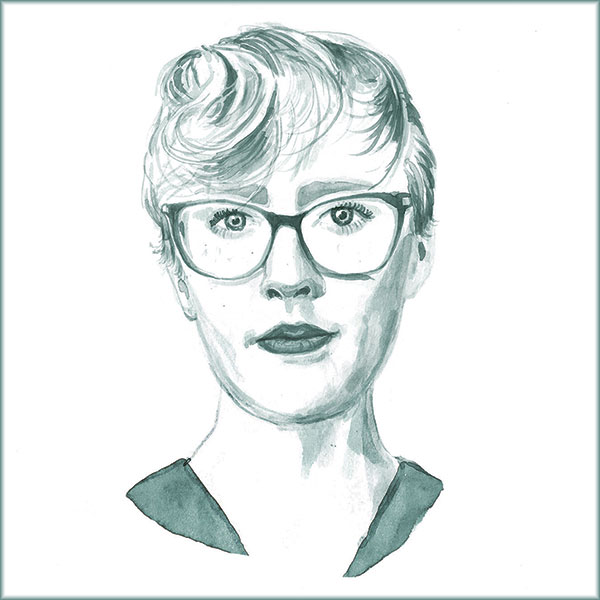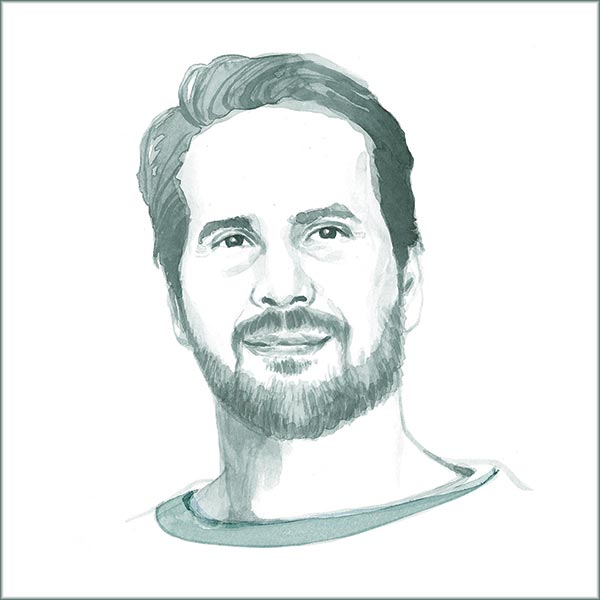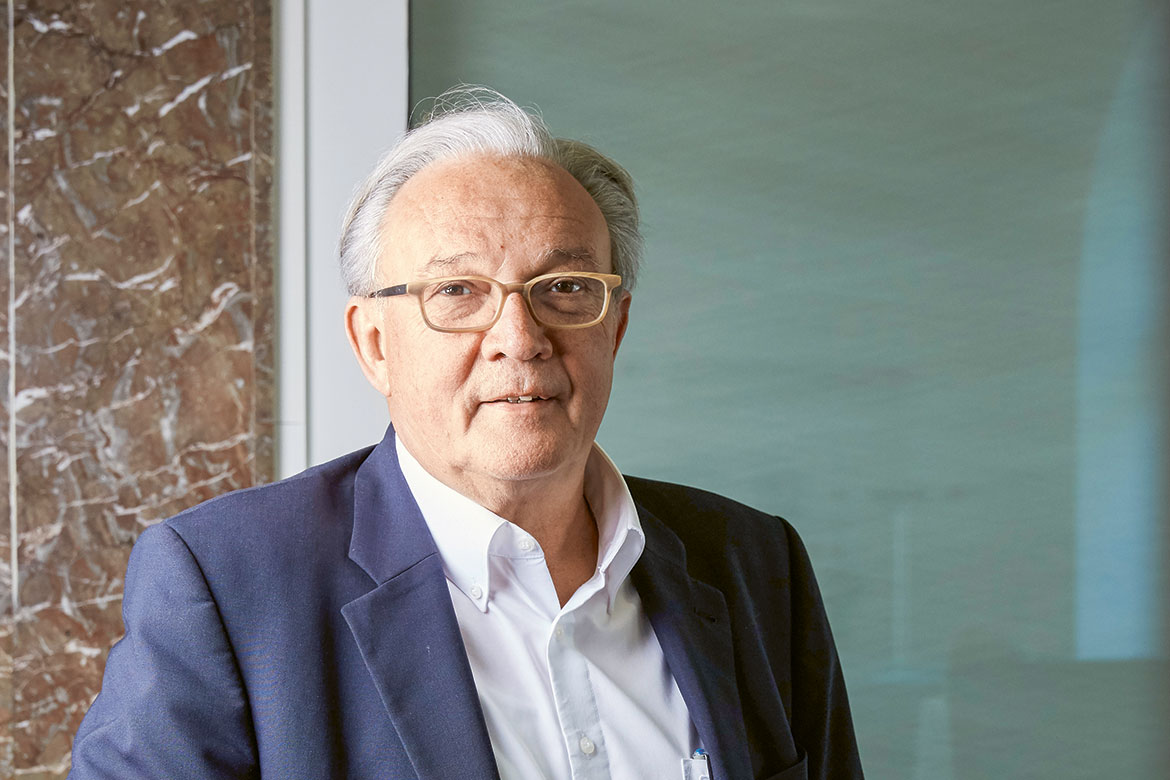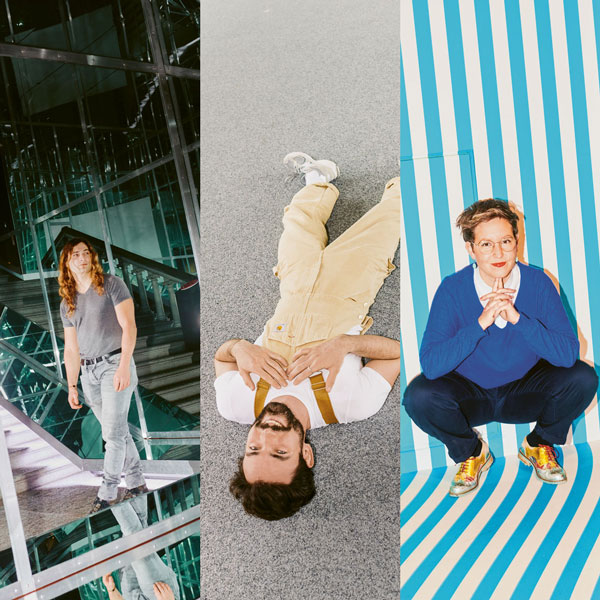Feature: Sports in the lab
Insights into the gaze of top athletes
Using virtual playing fields, researchers and sportspeople can really let off steam and investigate matters such as how the tiniest eye movements determine sporting success. Horizons pays a visit to the Sensorimotor Laboratory at the University of Bern.
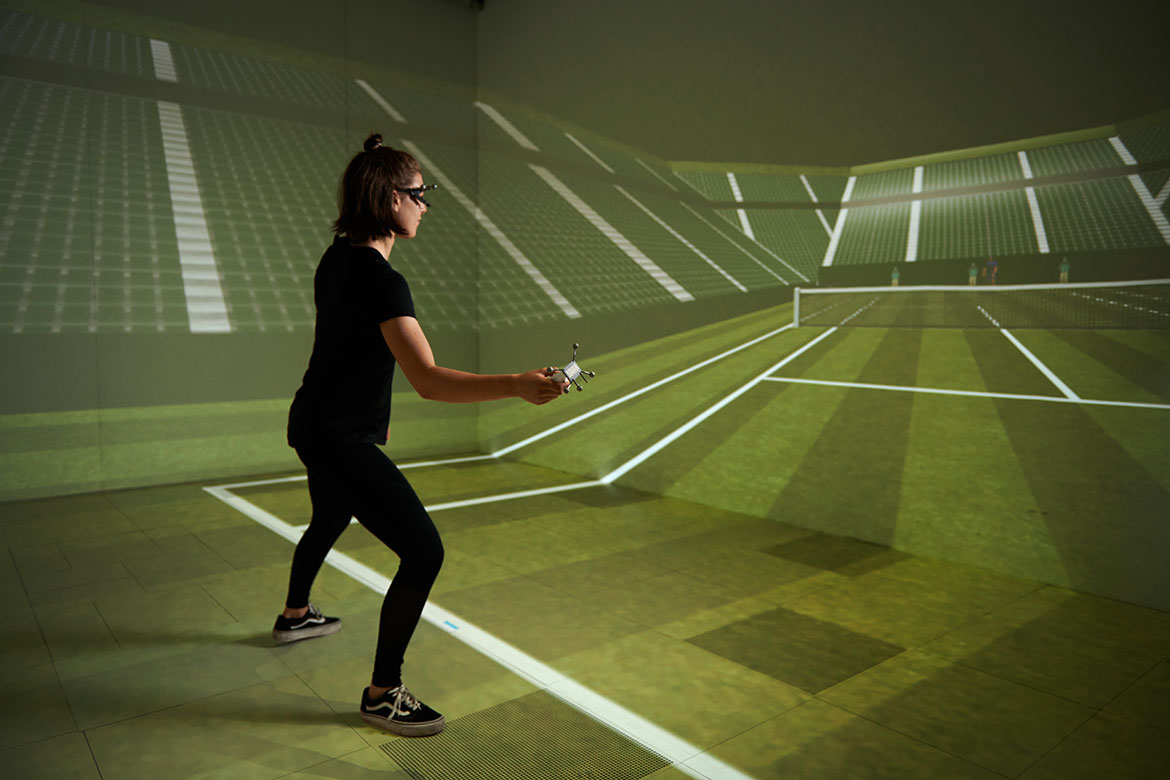
In the tennis simulator of the Institute of Sport Science at the University of Bern, the gaze of the study participant is investigated, including her perception of the position of the ball. | Photo: Gian Paul Lozza
His opponent serves again. This time slightly to the right. The sports student Nicola reaches the ball, but only with the edge of his tennis racket, and the yellow felt ball flies off into the stands. Never mind: the game continues. Next serve. Nicola is able to return it, but the ball lands out again, behind the baseline. Nicola doesn’t let this get him down. With almost stoic resolve he does his best to return the next ball. After all, this is only an experiment. Neither the tennis court nor his opponent are real: they’re virtual.
We’re in the Sensorimotor Laboratory of the Institute of Sport Science at the University of Bern, where 20-year-old Nicola is a test subject helping the researchers to find out what determines the behaviour of tennis players and other sportspeople. Top athletes in particular are under constant pressure when competing against each other, so they have to act very quickly and decisively – whether it’s returning a serve in tennis, defending a spike in volleyball or choosing the best corner of the goal when taking a penalty in football. But there is a lack of clarity about the prerequisites for these actions. Just how does the sensory perception of athletes function, and how do they assess their opponents? How do they make their decisions out on the playing field, what influences their behaviour, and just what is it that differentiates a top-class athlete from a hobby sportsperson? These are the questions that Ernst-Joachim Hossner’s team of sports scientists want to answer with their experiments.
The gaze determines movement
In the Sensorimotor Laboratory, the team can adjust and investigate playing situations in a virtual context. “You couldn’t do that with real games”, says Ralf Kredel, the head of the lab, “because the same situation hardly ever occurs twice”. At present, he is especially interested in the eye movements of sportspeople. Just what do players look at when they’re playing, and how does this influence how well they play? In order to analyse this, the test subject Nicola is wearing 3D goggles with an eye-tracking function. These goggles make the virtual tennis court as real as possible for him – the court, his opponent and the flying balls are projected onto the ground and walls using projectors. There are also two small infrared cameras pointed at Nicola’s eyes. The images they take are fed into a software program that determines the position of his pupils and reconstructs his line of vision.
Nicola’s opponent serves once more. Nicola himself is an all-round sportsman, as you can see from his broad shoulders and muscular arms. He moves his virtual racket using the controller that he holds in his hand, rather like the ones you use with a Wii gaming console. This time, he returns the serve, and the controller also shows where he saw the ball. This is important, “because we also want to know to what extent the test subject’s perception of the ball differs from its actual position, and what determines that difference”, says Kredel.
Infrared cameras also hang from the ceiling of the laboratory. Using reflective markers, they can record the movements of the test subject down to the nearest millimetre. The research team is currently in the pilot phase of the experiment. They check the position of the eye-tracking goggles and the controller, and combine this information with the data gathered about Nicola’s eye movements.
What makes a top-class athlete?
In earlier experiments, the team used similar methods to take a closer look at elite beach volleyball players. In beach volleyball, usually one player tries to block an attack at the net while the other covers the rest of the court. The players have to make different decisions: often, they will have to defend a long, diagonal smash across the court, or perhaps they will have to reach a ball that is just prodded over the net or placed in their court with a short, diagonal hit. “To manage this, even quick players can only start running, at the very latest, at the moment when their opponent touches the ball, otherwise they have no chance at all”, says Hossner. His team got together 64 volleyball players to analyse how these athletes anticipate where the ball will land. Half of them were hobby players, the others were the 16 best men and 16 best women players in Switzerland. These included internationally successful players such as Nadine Zumkehr and the multiple European champions Paul and Martin Laciga.
In their experiments on the virtual court, the researchers discovered that the best players always have the same patterns of eye movement when defending. They look briefly at the opponent who is passing the ball, then at the run-up of the opponent who is about to attack, and then at the point above the net where they estimate that the ball will be hit. Beginners and average players, however, have a gaze that is far more restless, wandering here and there across the court. As a result, their grasp of the playing situation is less reliable.
In calm lies the secret to success
It is in this context that Hossner speaks of the ‘quiet eye’ of the professionals. Its impact can best be observed in rather static processes, such as a free throw in basketball. Those who look longer at the basket before throwing the ball have a higher rate of success. It’s similar in volleyball: those who look early at the contact point – the point where the opponent will touch the ball – are more successful in defending. This ‘quiet-eye technique’ exists in tennis too, as earlier experiments by the Bernese team have shown. Whoever looks early at the point where the opponent’s ball will hit one’s own side of the court will have a better chance of returning it.
Of course it would be great if you could simply practise this ‘professional gaze’ to become a better player. “But regrettably, it doesn’t work as straightforwardly as that”, says Hossner. Their experiments have shown that if those in training concentrate too much on their eye movements, then they become less attentive to the most important thing: actually hitting the ball. They don’t get better; they get worse. “Often, this is done wrongly in training”, says Hossner. “Instead of instructing the players where they should look, it would be better to give them clever practice exercises that would automatically lead their gaze to the right point”.
Assessing your opponent
But how do experienced players anticipate this contact point with a quiet eye? Hossner’s team visited the Beachworldtour Gstaad, where the best in the world compete, and conducted interviews there that can provide us with some answers. The players claimed that they do not just orient themselves according to the position and stance of their opponents, but also on how they have played up to that point – they try and guess which is their preferred corner, and where they aim the ball when under pressure. “This is where it gets exciting, because there is still little research into how one’s expectations of one’s opponents alters how one behaves when playing, and how often these assessments of an opponent are correct”, says Hossner.
These are precisely the issues that his team is investigating in their current tennis research. Over time, Nicola’s ‘opponent’ will increasingly serve in the same direction. The researchers want to know: to what extent will Nicola’s pre-knowledge influence where he looks, his perception of where the ball will land, and – ultimately – his success in returning the ball? “It would be ideal if these expectations helped the players to steer their gaze, but without distorting their sense of perception”, says Hossner.
Desperately seeking talent
In one corner of the lab in which virtual tennis balls are still whizzing past Nicola, there is a single, lonely football – a leftover from the team’s last experiment. It was all about creativity. “Creativity is an extremely popular concept in football”, says Hossner. In an experiment with the U12 and U13 teams of Young Boys Bern, it transpired that creativity on the football pitch almost exclusively depends on the technical ability of the players. “A result like this helps the trainers”, says Hossner. “It shows them that they shouldn’t be looking for players with imagination, but just those with sheer footballing ability”.
But how do you find footballing talent, and what is this ‘talent’ anyway? These are issues being investigated by Achim Conzelmann and his own team at the University of Bern. Their results have shown that it’s by no means just physical, motor characteristics that play a role. Of course there are basic prerequisites for every type of sport for those who really want to make it to the top. In endurance sports such as cycling or cross-country skiing, for example, you need a specific, high-level oxygen intake per kilogram of body weight. In volleyball and basketball, young players are not even given any support unless their parents are of a specific minimum height. “It’s a bit more complex in sports such as football or tennis, because sporting achievement in them comes about through different factors”, says Conzelmann. “Roger Federer and Rafael Nadal, for example, have very different physical characteristics, but they are both extremely successful”.
Your psyche and family also play a role
What both these athletes have in common is an extraordinary motivation to achieve. As Conzelmann’s results have proven, this is the most important success factor of all. He has carried out physical and psychological tests with young footballers from the age of 12 upwards, and later checked to see who got into the final selection for the Swiss U15 team. He found that those who had the personal motivation to improve all the time were more successful, and had a better chance of becoming a professional footballer, than those whose motivation was primarily to win.
Another important factor proved to be the family environment. “For kids to get really good, they have to train so often and hard that this would be impossible without the support of their families”, says Conzelmann. “That’s one reason why footballers from immigrant families tend to be more likely to become professional”. Often, immigrants see their child’s talent as an opportunity for the whole family. Swiss families, by contrast, often place a greater emphasis on a school education.
Nicola obviously doesn’t lack the motivation to succeed. He tries calmly, time and again, to hit the virtual ball. His session today lasts two hours, and he’ll be at it again next week. In total, he and the other 39 test subjects will have faced 760 serves each.

